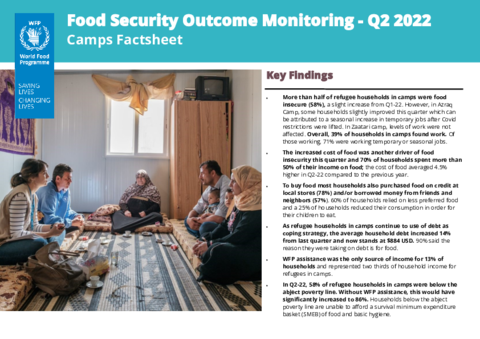
This factsheet provides a summary of the main findings of a Food Security Outcome Monitoring (FSOM) exercise conducted in June 2022 covering households living in the camps.
During Q2 2022, WFP Jordan responded to the food needs of up to 462,736 refugees, 231,368 females and 231,368 males, through the provision of monthly food assistance in the form of cash-based transfers. Assistance was provided in both host communities and camps, covering 348,718 refugees living in communities and 114,018 refugees living in camps. To ensure that assistance is effective, efficient, relevant, and aligned with organizational commitments towards protection and inclusion, the WFP Jordan Country Office conducts quarterly food security outcome monitoring (FSOM) exercises covering WFP beneficiaries in Jordan.
- More than half of refugee households in camps were food insecure (58 percent), a slight increase from Q1-22. However, in Azraq Camp, some households slightly improved this quarter which can be attributed to a seasonal increase in temporary jobs after Covid restrictions were lifted. In Zaatari camp, levels of work were not affected. Overall, 39 percent of households in camps found work. Of those working, 71 percent were working temporary or seasonal jobs.
- In Q2-22, 58 percent of refugee households in camps were below the abject poverty line. Without WFP assistance, this would have significantly increased to 86 percent. Households below the abject poverty line are unable to afford a survival minimum expenditure basket (SMEB) of food and basic hygiene.
